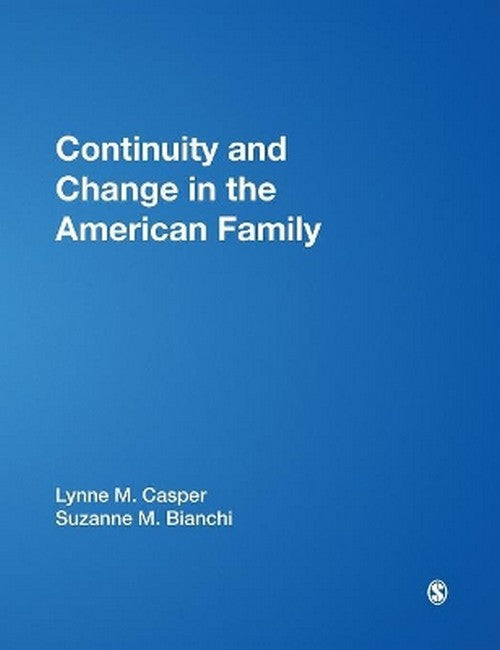Lynne M. Casper received her Ph.D. in demography and sociology from Penn State in 1992. She is currently Health Scientist Administrator and Demographer in the Demographic and Behavioral Sciences Branch at the National Institute of Child Health and Human Development. She is also director of NICHD's training program in population studies and is program officer for many national data collection efforts. She has published numerous scholarly articles in the areas of families and households, cohabitation, fatherhood, childcare, voting and demographic methods. She previously spent 7 years as a Demographer and Statistician in the Fertility and Family Statistics Branch at the U.S. Census Bureau where she was senior analyst for the family and households, childcare and voting programs. She has authored nearly a dozen Census Bureau Current Population Reports. She was awarded Vice-President Gore's Hammer Award for her work on fatherhood with the Interagency Forum on Child and Family Statistics. She is currently a member of the NICHD Family and Child Well-being Research Network and the Federal Interagency Forum on Child and Family Statistics. Suzanne M. Bianchi received her Ph.D. in Sociology from the University of Michigan in 1978. She is currently Professor of Sociology and Faculty Associate in the Center on Population, Gender, and Social Inequality, at the University of Maryland and also an Affiliate Faculty member of the Women's Studies Department and the School of Public Affairs. Prior to her current position, she was a U.S. Census Bureau demographer for 15 years and served as Assistant Chief for Social and Demographic Statistics in the Bureau's Population Division in 1993-94. Her recent publications explore the interrelationship between maternal employment and time with children, women's financial status and the probability of divorce, the gender division of housework, the relationship among marriage, children, and women's employment, the feminization and juvenilization of poverty, the economic well-being of nonresident fathers and custodial mothers, and children's use of time. She served as President of the Population Association of America in 2000 and has chaired the Population and Family Sections of the American Sociological Association as well as guest edited a special volume of Demography on "Men in Families" in 1998.
Request Academic Copy
Please copy the ISBN for submitting review copy form
Description
Acknowledgments Introduction Is the American Family in Decline? A Note on the Demographic Approach to Studying Families. Theoretical Frameworks in Family Demography. A Note on Data and Family Terminology. Choice of Topics and Organization of this Volume. 1. Changing Families in a Changing Society A Changing Society. Changing Households and Families. Racial Differences in Household and Family Structure. Delayed Marriage and Living Arrangements of Young Adults. Cohabitation. Marriage, Divorce, and Remarriage. Childbearing. Living Arrangements of the Elderly. Intergenerational Ties and Multigenerational Living. 2. Cohabitation Who Cohabits and How Has This Changed Over Time? A Note on Gay & Lesbian Cohabiting-Couple Households. Cohabitation and Marriage. Are Cohabiting and Married Individuals Becoming More Alike? Cohabitation and Single Life. Different Purposes, Different Cohabitors. Race and the Meaning of Cohabitation. Premarital Cohabitation and Risk of Divorce. 3. Childbearing - M. O'Connell Entering Motherhood: Childbearing Among Cohorts of Women. Number of Children and Childlessness. Generational Differences in Childbearing. Nonmarital Childbearing. Employment Patterns Before and After Pregnancy. Birth Expectations. Fertility in Men's Lives. 4. Single-Mother Families Who Is a Single Mother? Trends in Single Motherhood. Cohabitation and Single-Parenting. Cohort Change in Lifetime Experience of Single-Mothering. Changing Socioeconomic Characteristics of Single Mothers. Variation among Single Mothers. Single Mothers and Welfare Reform. 5. Fathering Beliefs about Father Involvement: Ideals & Realities. Declining Fatherhood: Long-Term Trends in Men's Coresidential "Parenting." Lifetime Estimates of Parenthood. Father-Only Families & Cohabitation. Characteristics of Single and Married Fathers. Child Custody. Contact Between Nonresident Fathers & Their Children. Child Support Among Nonresident Fathers. Married Fathers' Time and Activities with Children. Fathers' and Mothers' Views on Father Involvement. 6. Grandparenting How Has Grandparenthood Changed Over the Years? Grandparenting. Grandparenting and Single-Parenting. Multigenerational Families with Grandparents. Heterogeneity in Multigenerational Families with Grandparents. Characteristics of Grandparents in Multigenerational Families. The Economic Well-being of Grandparents in Multigenerational Families. Racial Differences in Multigenerational Families with Grandparents. The Economic Well-being of Grandchildren in Multigenerational Families. 7. Child Care Growth in Non-Parental Child Care. How Do Parents Choose Child Care? Complexity of Child Care Arrangements. Child Care and Child Well-Being. 8. Child Well-Being Changing Numbers of U.S. Children. A Transformation of Family Life. Foster Children and Adopted Children. Children in Gay and Lesbian Families. Children's Economic Security. Parents & Children. How Do Children Spend Their Time? Children's Health. Teens, Mortality, and Risky Behaviors. 9. Economic Causes and Consequences of Changing Family Structure Trends in Household & Per Capita Income. Poverty Trends. Racial Differences in Income & Poverty. "Feminization" of Poverty. Changing Employment & Earnings of Women. Declining Male Wages. The Juvenilization of Poverty. Family Income Inequality & Relative Economic Well-Being. Components of Rising Household Income Inequality. Changing Economics & Family Formation & Dissolution. Men's Income & Their Attractiveness in the Marriage Market. Women's Economic Independence, Marriage, & Marital Disruption. Consequences of Marital Disruption in Families with Children. The Gender Gap in Income After Marital Disruption. 10. Combining Work and Family The Increase in Mother's Labor Force Participation. Attitudes about Women's Work. Women's & Men's Nonmarket Work. When Do Men Do More Housework? Perceived Success at Work-Family Balance. Dual Earning & Family Well-being. Conclusion References Index About the Authors

